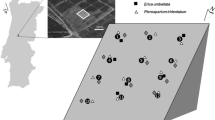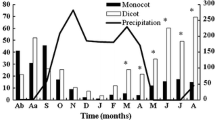Abstract
The impact of fire on hard-coated Cistaceae (Halimium ocymoides, Cistus ladanifer, and C. salvifolius) soil seed banks in a Mediterranean 'maquis' shrubland, and its effect on seed germinability were studied. The study also contrasts the effectiveness of two widely used techniques for quantifying seed banks, the seedling emergence and the physical separation methods, in relation to fire. The null hypothesis that a massive enhancement of physically-dormant Cistaceae seed germination by fire would make use of the time-consuming physical separation technique unnecessary was tested. Fire reduced Cistaceae seed banks in the 0–2 cm deep soil layer by both seed fire-consumption and lethal temperatures, revealed by the significant decreasing of the seed bank density and by the increase of apparently-intact but soft-unviable seeds, respectively. In contrast, no damage was recorded in the 2–5 cm soil layer. A dramatic seed bank depletion (> 90%) in both soil layers was recorded one year after fire in the burnt area, coinciding with a significant increase of seedling density confined to the first post-fire year. The ecological consequences of this massive post-fire seed bank input are discussed. A germinability test revealed that germination of surviving Cistaceae seeds was significantly enhanced in all cases except for the C. salvifolious seed bank in the deeper soil layer. However, final germination levels (60–75%) did not correspond to the magnitude of seed bank depletion, especially for C. salvifolious, which suggests that other environmental factors not exclusively associated with fire may also be important in softening Cistaceae seeds. Germination enhancement by fire soil-heating was not high enough to reject the physical separation technique, at least in the deeper soil layer. The simultaneous use of both seedling emergence and physical separation is recommended for reliable seed bank estimates when a physically-dormant hard-seeded component can be expected in the soil, as in many Mediterranean ecosystems, regardless of fire occurrence.
Similar content being viewed by others
References
Auld, T. D. & O'Connell, M. A. 1991. Predicting patterns of post-fire germination in 35 eastern Australian Fabaceae. Austr. J. Ecol. 16: 53-70.
Arianoutsou, M. & Margaris, N. S. 1981. Early stages of regeneration after fire in a phryganic ecosystem (east Mediterranean). I. Regeneration by seed germination. Biol. Ecol. Méditer. 8: 119-128.
Baskin, J. M. & Baskin, C. C. 1989. Physiology of dormancy and germination in relation to seed bank ecology. Pp. 53-66. In: Leck, M. A., Thomas, V. T. & Simpson, R. L. (eds), Ecology of Soil Seed Banks. Academic Press, San Diego, California.
Besnier, F. 1989. Semillas. Biología y Tecnología. Ed. Mundi-Prensa, Madrid, 635 pp.
Christensen, N. L. & Muller, C. H. 1975. Effects of fire on factors controlling plant growth in Adenostoma Chaparral. Ecol. Monogr. 45: 26-55.
Christensen, N. L. & Kimber, P. C. 1975. Effects of prescribed burning on the flora and fauna of south-west Australian forests. Porc. Ecol. Soc. Austr. 9: 85-106.
Corral, R., Pérez-García, F. & Pita, J. M. 1989. Seed morphology and histology in four species of Cistus L. (Cistaceae). Phytomorphology 39: 75-80.
Corral, R., Pita, J. M. & Pérez-García, F. 1990. Some aspects of seed germination in four species of Cistus L. Seed Technol. 18: 321-325.
De Bano, L. F.; Dunn, P. H. & Conrad, C. E. 1977. Fire's effect on physical and chemical properties of chaparral soils. Pp. 65-74. In: Mooney, H. H. & Conrad, C.E. (eds), Symposium on Environmental Consequences of Fire and Fuel Management in Mediterranean Ecosystems. U.S.D.A. Forest Service General Technical Report WO-3, Washington.
Ferrandis, P. 1996. Efecto del fuego sobre el banco de semillas del suelo en diferentes ecosistemas mediterráneos de Castilla-La Mancha. Ph. D. Thesis. University of Murcia, Spain.
Ferrandis, P., Martínez-Sánchez, J. J. & Herranz, J. M. 1998. Fire impact on a maquis soil seed bank in Cabañeros National Park (central Spain). Israel J. Plant Sci. In press.
Gaussen, H. 1970. Carte de la végétation de la région méditerranéenne. Notice explicative. UNESCO/FAO, Paris. 90 pp.
González-Rabanal, F. & Casal, M. 1995. Effect of high temperatures and ash on germination of ten species from gorse shrubland. Vegetatio 116: 123-131.
Gross, K. L. 1990. A comparison of methods for estimating seed numbers in the soil. J. Ecol. 78: 1079-1093.
Heywood, V. H. 1985. Las Plantas con Flores. Ed. Reverté, Barcelona. 332 pp.
Juhren, M. C. 1966. Ecological observations on Cistus in the Mediterranean vegetation. Forest Sci. 12: 415-426.
Kuhnholtz-Lordat, G. 1938. La Terre Incendiée. Essai d'Agronomie Comparée. Maison Carrée, Nimes, 361 pp.
Manders, P. T. 1990. Quantifying soil seed banks: A comparison of physical separation and seedling emergence techniques in Cape fynbos and forest vegetation. South Afr. J. Ecol. 1: 27-30.
Naveh, Z. 1974. Effect of fire in Mediterranean Region. Pp. 401-434. In: Kozlowski, T. T. & Ahlgren, C. E. (eds), Fire and Ecosystems. Academic Press New York.
NÚñez-Olivera, E., Martínez-Abaigar, J., Escudero, J. C. & García-Novo, F. 1995. A comparative study of Cistus ladanifer shrublands in Extremadura (CW Spain) on the basis of species composition and cover. Vegetatio 117: 123-132.
Purdie, R. W. 1977. Early stages of regeneration after burning in dry sclerophyll vegetation. II. Regeneration by seed germination. Austr. J. Bot. 25: 35-46.
Rolston, M. P. 1978. Water impermeable seed dormancy. Bot. Rev. 44: 365-396.
Ter Heerdt, G. N. J., Verweij, G. L., Bekker, R. M. & Bakker, J. P. 1996. An improved method for seed-bank analysis: seedling emergence after removing the soil by sieving. Funct. Ecol. 10: 144-151.
Thanos, C. A. & Georghiou, K. 1988. Ecophisiology of firestimulated seed germination in Cistus incanus subsp. creticus (L.) Heywood and C. salvifolius L. Plant, Cell, Env. 11: 841-849.
Thanos, C. A., Georghiou, K., Kadis, C. & Pantazi, C. 1992. Cistaceae: a plant family with hard seeds. Israel J. Bot. 41: 251-263.
Thompson, K. & Booth, R. E. 1993. Dormancy breaking. Pp. 187-190. In: G. A. F. Hendry & J. P. Grime(eds), Methods in Comparative Plant Ecology. A Laboratory Manual. Chapman & Hall, London.
Thompson, K., Bakker, J. & Bekker, R. 1997. The Soil Seed Banks of North West Europe: Methodology, Density and Longevity. Cambridge University Press, United Kingdom. 276 pp.
Trabaud, L. 1970. Quelques valeurs et observations sur la phytodynamique des surfaces incendiées dans le Bas-Languedoc. Nat. Monspel. Ser. Biol. 21: 231-242.
Trabaud, L. 1980. Influence du feu sur les semences enfouies dans les couches superficielles du sol d'une garrigue de chêne kermes. Natur. Monspel. Ser. Biol. 39: 1-12.
Trabaud, L. 1992. Influence du régime des feux sur les modifi-cations a court terme et la estabilite a long terme de la flore d'une garrigue de Quercus coccifera. Rev. Ecol. (Terre Vie) 47: 229-251.
Trabaud, L. 1995. Modalités de germination des cistes et des pins méditerranéens et colonisation des sites perturbées. Rev. Ecol. (Terre Vie) 50: 3-14.
Trabaud, L. & Oustric, J. 1989. Comparaison des stratégies de régénération après incendie chez deux espèces de cistes. Rev. Ecol. (Terre Vie) 44: 3-13.
Troumbis, A. & Trabaud, L. 1986. Comparison of reproductive biological attributes of two Cistus species. Acta Oecol. (Oecol.Plant.) 7: 235-250.
Troumbis, A. & Trabaud, L. 1987. Dynamique de la banque de graines de deux espéces de cistes dans les maquis grecs. Acta Oecol. (Oecol.Plant.) 8: 167-179.
Tutin, T. G., Heywood, V. H., Burges, N. A.; Moore, D. M., Valiente, D. H., Walters, S. M. & Webb, D. A. 1964-1980. Flora Europaea. Cambridge University Press, Cambridge.
Valbuena, L., Tárrega, R. & Luís, E. 1992. Influence of heat on seed germination of Cistus laurifolius and Cistus ladanifer. Int. J. Wildland Fire 2: 15-20.
Vuillemin, J. & Bulard, C. 1981. Ecophysiologie de la germination de Cistus albidus L. et Cistus monspeliensis L. Nat. Monspel., Sér. Bot. 46: 1-11.
Zar, J. H. 1984. Biostatistical Analysis. 2nd edition. Prentice-Hall, New Jersey, 718 pp.
Author information
Authors and Affiliations
Rights and permissions
About this article
Cite this article
Ferrandis, P., Herranz, J.M. & Martínez-Sánchez, J.J. Effect of fire on hard-coated Cistaceae seed banks and its influence on techniques for quantifying seed banks. Plant Ecology 144, 103–114 (1999). https://doi.org/10.1023/A:1009816309061
Issue Date:
DOI: https://doi.org/10.1023/A:1009816309061




